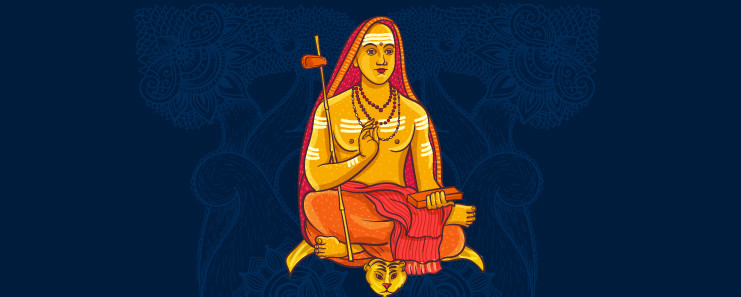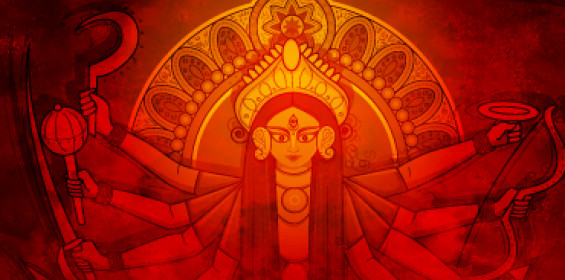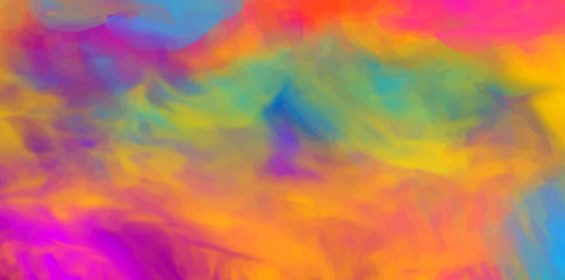na ca vyoma bhūmir na tejo na vāyuḥ
cidānandarūpaḥ śivo'ham śivo'ham
I am not the seven elements or the five sheaths, I am the eternal knowing and bliss,
The auspicious, love and pure consciousness
These lines come from the Nirvana Shatkam or Atma Shatkam, the composition written by Jagadguru Adi Shankaracharya in 5th century BC. Many spiritual seekers have said that meditating on Atma Shatkam is one of the shortcuts to enlightenment. I was 21 when my mother, a Sanskrit scholar, introduced me to G.V. Iyer’s 1983 film Adi Shankaracharya. As my mother had excitedly described it, G.V. Iyer’s rendition of Jagadguru’s life was shot with Sanskrit as the spoken language and the film had won 4 Indian National Awards.
I watched the film for the first time for the experience of seeing a Sanskrit film with English subtitles. But as my view counts increased, the wonder was largely on the life of Adi Shankaracharya and everything he had accomplished before leaving his body at the age of 32. On the occasion of Shankaracharya Jayanti, let’s read about some of the lesser-known stories from the life of the father of Advaita principle (According to which, there is no duality in the universe, everything is made up of one source - the brahman).
Early life and renunciation
There is a colloquial Hindi proverb that says, ‘you can see the feet of a child in his pram’. This idiom signifies that quite often, children show glimpses of their future endeavors in their childhood. This proverb fits perfectly on Adi Shankaracharya.
According to the Shankaracharya mathas, Adi Shankaracharya, or Shankara, was born in 509 BCE in Kerala and he had established the four mathas by 477 BCE.
Shankara, as a child, watched a play by a traveling drama company on the life of Nachiketa and his conversations with Yama, the god of death. These conversations form the basis of Katho Upanishad. So moved was young Shankara by that play that he decided to renounce the world and be a spiritual seeker.
Our ancient sages mastered the secrets of the breath and the mind. In many ways, this is our heritage. Unlock these secrets in these modern times, and keep the legacy alive at The Art of Living Meditation and Breath Program.
Learn what our ancients knew about the mind and breath. They are all the remedies you will need. I'd like to know more >>
It is said that as a young child, Shankara was bathing at the bank of a lake when he saw a crocodile approaching him. Shankara’s friends rushed to his mother, who had been unwilling to give her permission to Shankara for renunciation, and told her about the crocodile. His mother rushed to the bank but the friends kept shouting that he won’t move away from the path of the crocodile until she gave Shankara permission for renunciation. A deeply religious woman herself, Shankara’s mother gave him the permission he needed to be a hermit.
In search and service of his master
After bidding farewell to his mother, Shankara started from the southern state of Kerala and walked almost 2000 kms to the banks of River Narmada in search of his master, Govindapadacharya. After finding his master, Shankara stayed with him and served Govindapada for four years. When he was 12, Govindapada stated that Shankara was ready to write commentaries on the main Vedic scriptures - Upanishads, Brahma Sutras, and the Bhagavad Gita.
In four years, Shankara completed the commentaries, highlighting the subtle symbolism hidden in the erudite text of the scriptures. It was then that Govindapada blessed his disciple to travel the country and bring the eternal message of the Vedas to the masses.

Shankaracharya’s digvijaya around India
The populace in those times had been tied down by several layers of scriptural misinterpretations. There were numerous sects, each propagating their version and extrapolation of Vedas. The prime focus of all sects was on the rituals and none of them focused on the essence behind those rituals. This led to confusion and degradation of societal dharma. And, the gist of Sanatana Dharma, with its comprehensive message of compassion, love, and the universal consciousness and humanity got lost.
I had seen, and even read some of the scriptures while growing up. And it amazed me that Adi Shankaracharya condensed the essence of all of them in just one line - Brahma Satyam Jagan Mithya, Jeevo Brahmaiva Na Para. This means that Brahman, the pure consciousness, is the ultimate reality; the world is an illusion and there is no difference between the individual consciousness and the Brahman.
In his Digvijaya, the young Adi Shankara challenged leaders of different sects and the eminent scholars of those times. The sects championed their extrapolation of the scriptures but they were all bested by Adi Shankaracharya and understood the wisdom in his teachings.
Our ancient sages mastered the secrets of the breath and the mind. In many ways, this is our heritage. Unlock these secrets in these modern times, and keep the legacy alive at The Art of Living Meditation and Breath Program.
Learn what our ancients knew about the mind and breath. They are all the remedies you will need. I'd like to know more>>
Did you know?
There is a famous legend of the debate between Adi Shankaracharya and Madana Mishra. Madana was a famous scholar in ancient India who, with his prodigious memory, knew all the scriptures by heart. It is said that the debate between Adi Shankara and Madana Mishra continued for several days, with no end in sight. It was then that the wife of Madana devised a plan to surmise the winner.
She placed a garland of flowers on Adi Shankaracharya’s neck and another on her husband’s neck. As the debate continued, the flowers around Shankaracharya’s neck were swarmed with flies while the flowers around Madana’s neck started withering.
With this happening, she extrapolated that the flowers around Madana’s neck started withering because he was speaking knowledge on a theoretical level. Whereas, Adi Shankaracharya was speaking the same on an experiential level. This concluded the debate in favor of Adi Shankara and Madana Mishra agreed to be his disciple. It was then that Madana was given the name of Vartikakara.
Bringing everyone together and difference with Buddhism
Because of the several sects following their individual interpretations of the scriptures, the common populace was blind to the commonality of the one god in every sect. To rectify this, Adi Shankaracharya first created four ashrams or mathas in four corners of India - Dvaraka, Kanchi, Badrinath, and Govardhana. He entrusted the working of these mathas to his four disciples - Padmapada, Hastamalaka, Trotakacharya, and Vartikakara. It was their responsibility to teach and promote the teachings of Advaita among them.
Another aspect that amazed me was that the area covered by Adi Shankaracharya in his digvijaya is the same area that is in present-day India. For the benefit of the common populace, Adi Shankara formed the six sects of worship to the main gods - Shiva, Vishnu, Shakti, Surya, Ganesha, and Muruka. Shankara also prepared the rites and rituals that would be followed for worship in most of India’s major temples.
For me, the most beautiful aspect of Adi Shankaracharya’s commentaries and teachings of the Brahma Sutras can be surmised in the way he differentiated between the teachings of Sanatan Dharma and Buddhism. There is a famous Buddha quote that, ‘When I went inside, I found nothing, no self, no soul.’ To this, Adi Shankaracharya had countered with, ‘The one that had gone inside and found nothing, that being was the self, the soul, the Brahman.’ From nothing to Brahman in just one simple, wonderful step.
na cāsaṅgataṃ naiva muktir na meyaḥ
cidānandarūpaḥ śivo'ham śivo'ham
I have no wishes for anything, even for liberation. Because I am indeed,
The eternal knowing and bliss, the auspicious, love and pure consciousness
The most haunting part of the film that remained with me throughout the years was the role that two children played, always accompanying Adi Shankaracharya. My mother told me that those two kids symbolized death and wisdom. She said that G.V. Iyer showed us that Adi Shankara was forever accompanied by his immense wisdom and the awareness of death, giving him the dispassion to move through his life unattached to everything. This is perhaps surmised by the last lines of the Atma Shatkam where Adi Shankara says that he doesn’t even wish for liberation as he is indeed, Sat Chit Ananda rupaha Shivoham Shivoham.
You too can read more about Adi Shankaracharya and listen to Gurudev Sri Sri Ravi Shankar’s commentaries on the Brahma Sutras here.
The material has been sourced from @bharathgyan. This research team, led by a passionate husband-wife duo - Dr. DK Hari and Dr. Hema Hari, unearth some of India’s untold stories and make them contemporary. You can click here to buy any of their books on Indian civilization.
Written by: Suraj Duseja
We’d love to hear from you
Leave your comments @artofliving



































